 |
| The Vamps DVD cover |
 |
| I fucking so instagrammed this |
The radical notion that women like good movies
 |
| The Vamps DVD cover |
 |
| I fucking so instagrammed this |
 |
| Lena Dunham and the cast of Girls |
Written by Stephanie Rogers.
I have yet to hear anyone react to the news of an advance with, “Yep, that seems about right.” It would be great if the writers and books that deserved the most money got it—ditto the same amount of attention and praise. And all the gripe-storming about how slight her book proposal was, and how she’ll never make back her advance—when did we start reviewing book proposals? When did writers start caring so passionately about publishers recouping their losses?
The entertainment industry is not a meritocracy. From before the days of Barrymore to our present age of Bacons and Bridges, Sheen-Estevezes and Zappas family has, for better and worse, equaled opportunity. The Coppola family’s connections and influence are so vast they’d make the mob envious.
I hear the diversity criticism. However, to suggest that “Girls”—a show whose charm lies in part in its documentary-like feel—presents the universe these young women inhabit, working in publishing and the arts, as rich in racial diversity, would be, sadly, to lie. Besides, did anyone ever kvetch about Jerry Seinfeld’s lack of Asian friends?
It’s cute (read: pretty hypocritical, actually) to see this sudden spike in concern over television’s portrayal of women, but this fixation is propelled by the same sense of threatened dudeness that makes a show written by and about women so “controversial” in the first place. If television were an even playing field, Dunham would not be on the cover of New York magazine atop the subheading “Girls is the ballsiest show on TV,” nor would the debut of this series be such a massive deal. (Where are the cultural dissections of CSI: Miami?) The critics calling Girls disingenuous because it stars four white women should redirect their frustration toward misogyny itself, not at the one show trying to fight it.
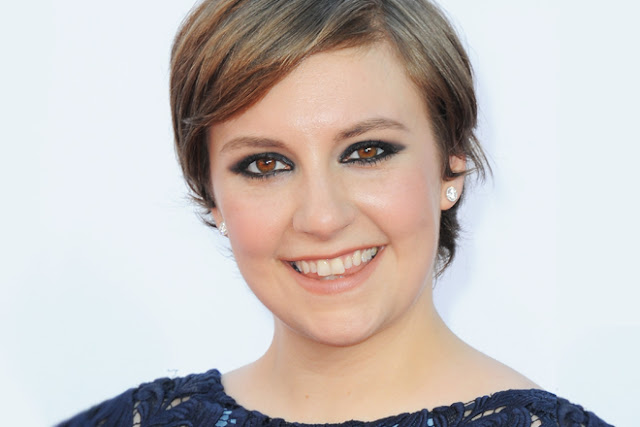 |
| Lena Dunham, probably getting ready to annoy people with her incessant whining |
Admittedly, I have a soft spot for Dunham, having written about her wonderful film Tiny Furniture way back in 2011, before she’d manage to offend the entire nation with her giant thighs and sloppy backside. I think she comes across as genuinely funny and interesting, and I hope that her success—and the hard hits she’s taking because of it—will make the next woman who dares to step out of line (where “line” means “the patriarchal framework”) do so with just as much fearlessness.
I mean, it’s not going to be like, “Hey guys, we’ve been out looking for a black friend or a friend in a wheelchair or a friend with a hat.” The tough thing is you kind of can’t win on that one. I have to write people who feel honest but also push our cultural ball forward.
Here’s what I think, after watching the first half hour of the season: I admire that Dunham took the criticism she got last year to heart. There are so many examples of how Hollywood ignores this type of thing. In fact, there are whole websites devoted to it. It really seems like she listened; I can’t tell from thirty minutes that everything has been solved, but it seems to be off to a good start? Lena Dunham isn’t so bad? Maybe? I say that with reservation but enthusiasm. Before I go, a couple thoughts on the good and the bad:
Good: I’ll start with positive reinforcement: Girls is definitely more diverse this season!
Bad: That definitely wasn’t the hardest thing to do.
Good: Donald Glover as Sandy! Hannah’s new, fleshed-out, not at all T-Doggy boyfriend.
Bad: I’m just hoping Donald Glover won’t simply be this show’s Charlie Wheeler.
Good: About the extras: A marked improvement in the representation of Brooklyn’s racial mix. So, Lena Dunham created a popular show, a critically acclaimed show, and instead of being, like, “Whatever. They’re all going to watch me anyway!” she actually made an effort to improve her show. That’s good. Very good. And to be honest, she probably realizes that a more realistic mix equals a more realistic world for her characters to live in.
Bad: Again, this is about the extras: There are definitely more black people on the show, but … I mean … I’ll put it this way. Realistic diversity is definitely not in your first season, girl. But it also not this. It’s definitely realistic here. But—it’s not this either, so don’t go overboard.
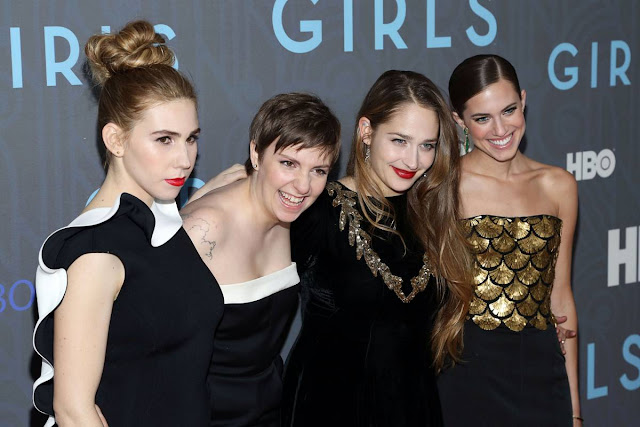 |
| White Women |
Laura Bennett at The New Republic said this:
Dunham uses the Sandy plot line as an opportunity to skewer both the complaints of her critics—Hannah herself echoes them with the misguided assumption that her essays are “for everyone”—and her characters’ blinkered worldview. Glover’s arc on the show is brief, but he is key to illustrating the limited scope of Hannah’s experience. “This always happens,” Sandy tells Hannah during their fight. “I’m a white girl and I moved to New York and I’m having a great time and oh I’ve got a fixed gear bike and I’m gonna date a black guy and we’re gonna go to a dangerous part of town. All that bullshit. I’ve seen it happen. And then they can’t deal with who I am.” Hannah responds with an explosion of goofy knee-jerk progressivism: “You know what, honestly maybe you should think about the fact that you could be fetishizing me. Because how many white women have you dated? Maybe you think of us as one big white blobby mass with stupid ideas. So why don’t you lay this thing down, flip it, and reverse it.” “You just said a Missy Elliot lyric,” Sandy says wearily.
It is wholly unsubtle, but it is still “Girls” at its best, at once affectionate and credible and lightly parodic. There is Hannah: impulsive, oblivious, tangled up in her own sloppy self-justifications. And then there is Lena Dunham, the wary third eye hovering above the action. “The joke’s on you because you know what? I never thought about the fact that you were black once,” Hannah tells Sandy. “I don’t live in a world where there are divisions like this,” she says. His simple reply: “You do.”
And I find myself back at the same place I was when Maya and I talked about Beyonce. No, Dunham’s attempt to introduce racial discourse into her show doesn’t suddenly make it diverse, but I think she still deserves some credit. If it sounds like I’m saying: the white girl gets a pass for not painting an accurate portrait of Blackness because she doesn’t have lived context/experience, that’s exactly what I’m saying. Why do we expect “all or nothing” from anyone who dares to align themselves with a few feminist values, even if they don’t call themselves feminists? When will we begin the process of meeting people where they are?
And, as Samhita wrote on this topic, maybe we should spend less time “scrutinizing [Dunham’s] personal behavior instead of looking at the real problem—the lack of diverse representations of women in popular culture.” Do we need to see realistic representations of Black girlhood on television? Yes, that’s why we need more Black girls writing shows. *raises hand* Do we need examples of diversity in film? Yes, that’s why we need more people from diverse backgrounds writing them. Truthfully, I’d rather not leave that task up to a white girl with “no Black friends.”
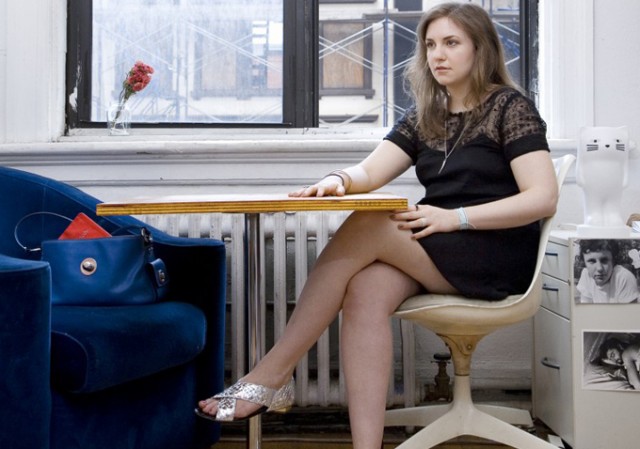 |
| Lena Dunham, being all entitled and shit |
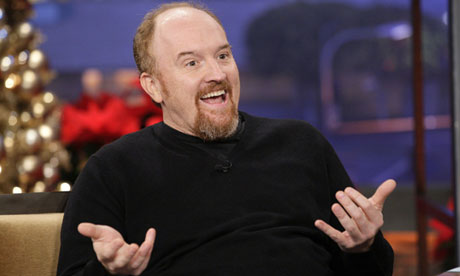 |
| “Eh, what are you gonna do?” –privileged White dudes everywhere, in response to rarely getting called out for their bullshit |
 |
| Movie poster for Silver Linings Playbook |
It went down like this: My sister and I were visiting my mom for Thanksgiving in the tiny but lovely and water-surrounded town of Solomons, Maryland. This was like a four-day adventure, and after spending one day eating, another day sleeping and watching football (don’t judge me), and another day accidentally setting off the entire alarm system at the college where my mom teaches Labor Studies, we thought … why not take a break from almost getting arrested and see a movie?
 |
| Jennifer Lawrence and Bradley Cooper in Silver Linings Playbook |
 |
| Jacki Weaver and Bradley Cooper in Silver Linings Playbook |
 |
| Jennifer Lawrence and Bradley Cooper in Silver Linings Playbook |
 |
| Bradley Cooper and Jennifer Lawrence in Silver Linings Playbook |
 |
| Jacki Weaver and Robert DeNiro in Silver Linings Playbook |
 |
| Bradley Cooper and Robert DeNiro in Silver Linings Playbook |
 |
| Movie poster for The Sessions |
Written by Stephanie Rogers.
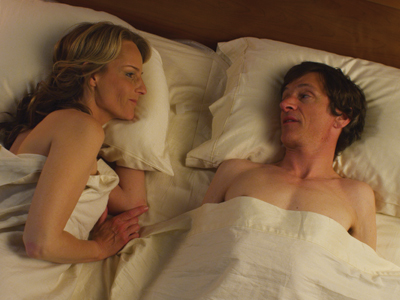 |
| Helen Hunt as Cheryl Cohen Greene and John Hawkes as Mark O’Brien in The Sessions |
That’s some pretty intense subject matter … not me being a lazy fuck—that’s for my therapist and me to work out SOMEDAY—but the serious exploration of a disabled man’s sexuality. While the focus remains on O’Brien throughout, The Sessions also gives us several comedic moments with other physically disabled characters as O’Brien interviews them for an article he’s writing about the sex lives of the disabled. I can’t tell you how refreshing it was to see an on-screen depiction of people with disabilities who do things like omg have sex and who also enjoy talking candidly and unapologetically about having sex. O’Brien’s reactions are hilarious; he gets fairly embarrassed and weirded out during the interviews, but the stories he hears ultimately empower him to think seriously about his own sex life, or lack thereof.
Enter the inimitable William H. Macy (yes!). He plays O’Brien’s priest, Father Brendan, who listens to O’Brien’s confessions every day while guiding him through the guilt he feels about seeking out a sex surrogate. That relationship soon evolves (once O’Brien begins spending time with the surrogate) into more of a friendship, and it’s wonderful to see those lines blurred; watching Macy go from praying with O’Brien in church for the first half of the film to showing up in sweats with a six-pack at O’Brien’s house in the later half got the whole theater cracking up. That friendship grounds the film and keeps it from veering into sentimental territory; the audience looks forward to their light-hearted conversations about some truly heavy subject matter. At the same time, their friendship adds emotional depth to the characters. We realize it isn’t just O’Brien’s physical disability that complicates his sexual exploration, but his Catholic faith as well. These two immensely likeable men clearly like each other—and their pontifications about the role of religion in their lives, and what God will and won’t forgive—keeps this from turning into yet another film about a dude just trying to get laid.
 |
| William H. Macy as Father Brendan and John Hawkes as Mark O’Brien in The Sessions |
Before seeing the movie, I hadn’t heard about sex surrogates. The real Ms. Greene (who still practices at the age of 68) describes the difference between her profession and prostitution as follows:
If you go to a prostitute, it’s like going to a restaurant. You read the menu, you choose what you want, they prepare, they hope that you love it, and hopefully you want to come back.
With a surrogate, it’s like going to cooking school. You get the ingredients, you learn to make a meal together—and then the point is to go out into the world and share that and not come back.
 |
| Helen Hunt as Cheryl Cohen Greene in The Sessions |
Most reviews I’ve read of The Sessions focus on Hawkes’ ridiculously good performance as O’Brien—after all, his acting essentially comes from nothing more than his voice and facial expressions. Oscar nomination? Probably. But I’d like to focus on the women in the film, particularly Hunt’s portrayal of Cheryl Cohen Greene.
Helen Hunt ultimately brought The Sessions to life for me. She treats O’Brien with such care, both emotionally and physically, while always maintaining a directness with him that undercuts any potential melodrama. One of my favorite scenes in the film happens right after O’Brien’s first, very brief moment of vaginal penetration. Afterward, he asks, “Did you come, too?” to which she responds, “No, Mark, I didn’t.” I fell in love with the film right then; the innocence of his question and the honesty of her response created more intimacy than most faux-passionate, desperation-filled Hollywood sex scenes could ever hope for.
And that’s the thing about Hunt’s performance. Hawkes, while indisputably great, wouldn’t be half as good in this role if he weren’t playing opposite Helen Hunt. She portrays Greene as confident and self-assured, with no lacy-underweared attempts at sexiness, and with only a tinge of sweetness. This isn’t a film about seduction. It’s mechanical and complicated and wonderful—at one point he has to stop performing cunnilingus because he can’t breathe; at another, she goes to the bathroom in front of him with the door open. Though she forges a strong bond with O’Brien emotionally, the goal always lingers: to help him lose his virginity and help him discover new ways to use and appreciate the human body, his own especially. Hunt says as much in an interview with the L.A. Times:
Maybe it all gets blurry near the end for a second … But I think that’s life—you can have some errant arrow prick your heart, but these two characters have an intention to keep to their mandate that this all is supposed to serve him. And both of them stick to that, painful as it is.
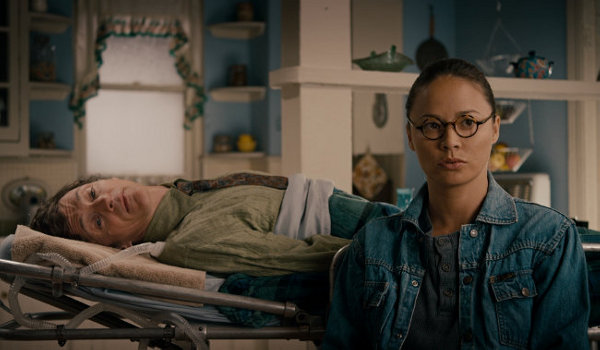 |
| John Hawkes as Mark O’Brien and Moon Bloodgood as Vera in The Sessions |
I’d like to say that all the women in the film were as wonderfully fleshed out and complex as Hunt’s character, but that isn’t true. O’Brien works with three women caretakers throughout, the first (and least conventionally attractive of which) he fires because she just kind of huffs around acting like an asshole. The second is a beautiful woman whose name I can’t remember, and her character development consists mainly of O’Brien gazing longingly over dreamy sequences of her hair blowing in the breeze and shit. Of course he proposes to her (why not!), at which point she quits … but then randomly shows up again later for an impromptu picnic in the park. Okay. The third woman caretaker, well, I kind of loved her. Vera (played by Moon Bloodgood) eases his anxiety more than anything, often making funny quips about sex and the not-a-big-dealness of it as she transports him to and from his sessions with Greene. That affords her an authentic intimacy that the other women characters—other than Greene, of course—don’t get to have. While the previous caretakers exist as shallow plot points to move O’Brien’s story forward, Vera shares a true friendship with him; in many ways, their relationship mirrors the directness and openness of his relationship with Greene.
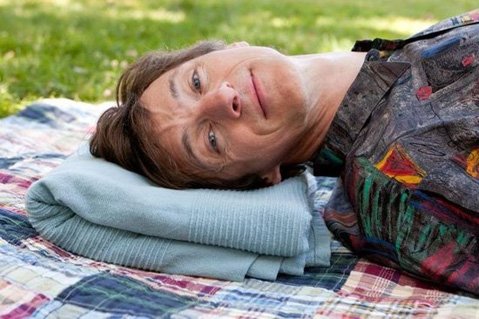 |
| John Hawkes as Mark O’Brien in The Sessions |
 |
| Movie poster for Vamps |
Jason Buchanan on Rotten Tomatoes effectively captures the plot as follows: “Radiant New York City vampires Goody (Alicia Silverstone) and Stacy (Krysten Ritter) find their immortality in question after learning that love can still smolder in the realm of the undead. Meanwhile, Russian bloodsucker Vadim (Justin Kirk) prowls the streets in search of the next big thrill, and Dr. Van Helsing (Wallace Shawn) seeks to exterminate the creatures of the night as young Joey Van Helsing develops an unusual fixation on Stacy. As ravenous ‘stem’ vampire Ciccerus (Sigourney Weaver) presides over her dark dynasty with the help of her loyal assistant Ivan (Todd Barry), oddball Renfield (Zak Orth) strives to impress Stacy and Goody by any means necessary. Amidst all of the bloodshed and intrigue, nefarious vampire Vlad (Malcolm McDowell) works to perfect his knitting skills.”
 |
| Alicia Silverstone as Goody and Krysten Ritter as Stacy in Vamps |
[SPOILER] Case in point: one of my absolute favorite scenes in the film happens early on, when Goody and Stacy head out for their nighttime ritual of club-hopping and imitating the new dance moves of the local youth “Day Walkers” (the term they use to refer to The Living among them). A couple of particularly horrible dude vampires approaches a woman after she bends over, ass in the air, with the word “Juicy” written on her tight pants. The dude vamps merely introduce themselves to her, to which she responds, “I’ll get my coat.” Goody chastises the horrible dude vampires—Goody and Stacy drink only the blood of rodents, not humans—and the dudes respond with, “She’s asking for it,” referring to her “Juicy” attire. It’s a pretty fucking great commentary on the victim-blaming that always accompanies any instance of the rape or sexual assault of women.
 |
| Stacy and Goody on the computer |
This scene makes me so happy for a couple of reasons. First, a woman intervening to help another woman avoid getting killed by two horrible dude vampires—an obvious metaphor for rape in this scene, rarely happens in movies. How lovely to see that! Because women looking out for their friends certainly happens in real life—first-hand experience! Second, while I don’t necessarily like the implication that women always go for Bad Boys, I appreciate the acknowledgment that bros like this, who want to harm, abuse, and assault women, definitely exist.
 |
| Stacy, Goody, and Sigourney Weaver as Cisserus in Vamps |
Two words: Sigourney Weaver. Do we not adore her? The Alien films, mainly due to Weaver’s badass role as Ellen Ripley, remain one of the quintessential go-to franchises for getting that much-needed feminist fix that Hollywood movies today seem less willing to provide. (Quick shout out to Hunger Games, though!) And Weaver’s role in Vamps as Cisserus, the head vampire, or “Stem,” as they refer to the few vampires who possess the power to turn people into vampires, displays some feminist qualities—strength, leadership, and ambition, to name a few—but her character isn’t without flaws.
While the other vamps fear Weaver’s character—because she’s In Charge—they mainly fear her because she’s the evil, murderous villain. She obsesses over acquiring the love of young men, and when she doesn’t get it, well, you know, she eats them. In many ways, she reminds me of a vampiric version of Miranda Priestly, Meryl Streep’s character in The Devil Wears Prada. She often summons Goody and Stacy (by psychically speaking to them), and it’s almost always to make them model clothing. (Ha!) See, vampires can’t see themselves in mirrors (invisible!), so Weaver wants to look at these women wearing her very youthful, fashionable clothing so that she can visualize what it possibly looks like on her. Eventually though, Cisserus’ power goes so far to her head that she begins putting the other vampires in danger, and the tagline for the last act of the film basically becomes “This Bitch Needs to Die.”
 |
| Vampires hanging out at the club |
Collider: What made you decide to jump into the vampire genre with Vamps?
Weaver: Well, I’m a big Amy Heckerling fan, and I also loved the character. She was so unrepentant … I love playing delicious, evil parts like that.
Collider: How does your character fit into the story?
Weaver: She is the person who turned the girls into vampires. So, they have to do her bidding, and she’s very unreasonable and demanding. I would have to say that the one change I made was that I thought she was not really enjoying herself very much, in the original script. I thought, “What’s not to enjoy?” She’s 2,000 years old, she can have anything, she can have anyone, she can do what she wants, so I wanted her to be totally in-the-moment. So, I talked to Amy about it and she just evolved that way. She’s a really happy vampire. She digs it.
 |
| Stacy and Goody at the club |
That’s why this close relationship between Goody and Stacy is so important to see on The Big Screen in 2012.
In an interview conducted with the director Amy Heckerling by Women and Hollywood, Melissa Silverstein asks the question, “Do you have any comment on the fact that only 5% of movies are directed by women?” Heckerling’s response? “It’s a disgusting industry. I don’t know what else to say. Especially now. I can’t stomach most of the movies about women. I just saw a movie last night—I don’t want to say the name—but again with the fucking wedding, and the only time women say anything is about men.”
Word.
 |
| Movie poster for The Master |
Slim at Gone Elsewhere does an excellent job of explaining the plot, so if you don’t know the plot, go there first … then come back here and let me explain to you why this movie is a piece of shit.
I went into it thinking it had the potential to be good because Paul Thomas Anderson made Magnolia, and Magnolia has some wonderfully nuanced and well-developed women characters, so I know he’s capable of not creating films exclusively about white dudes talking about stuff, but fuck, I honestly couldn’t get over his absolute reveling in the incessant blathering of white dudes to other white dudes.
Don’t get me wrong; Joaquin Phoenix’s emotionally disturbed character, Freddie Quell, totally makes a sand-woman on the beach—complete with breasts and spread legs—that he then proceeds to hump and fingerfuck in front of a group of cheering white dudes (even they get uncomfortable after a few seconds of this) before beating off into the oh-so-vast and Oscar-worthy cinematographically-shot ocean, but as far as women characters go, the sexually assaulted sand-woman left a little to be desired.
 |
| Freddie Quell pinching a sand-woman’s nipple in The Master |
Okay, okay, Amy Adams appears a few times, once to read a naughty sex passage from a book to Freddie—who wouldn’t want to hear Amy Adams say “opening the lips of her cunt” (or something) for no discernible reason?—and she shows up again to jerk off her husband (The Master!) Philip Seymour Hoffman over a fucking bathroom sink, so I don’t want to mislead anyone—women exist in this sea of white dudes talking about stuff, but in between giving handjobs, carrying around infants, defending their men, and gratuitously exposing their breasts to drunk and violent sociopaths, they’re just kinda blah.
I don’t want to mislead anyone. I’m not saying I haven’t exposed a breast or two to a sociopath in my day, but that doesn’t mean I found these ladies relatable, and that includes the violated sand-woman.
 |
| Amy Adams in The Master, looking pissed |
And I wish I knew what to say about Freddie’s love for a 16-year-old girl named Doris, especially since he looks like he’s in his mid-50s throughout the film. Okay, in fairness, Freddie only interacts with Doris in his memories (because this is art, people), so it makes sense that we never actually get to see Doris age. (But still, Freddie was either like 30 when she was 16, or they should’ve hired some better fucking makeup artists.)
Regardless of the potential statutory rape situation, Freddie can’t seem to get over his First Love because then we wouldn’t have the quintessential white dude movie plot dilemma: there’s a girl he can’t have, or a girl who died, or a girl he lost, or a girl he has to save—if there’s one thing we all know about films about white dudes talking about stuff, it’s that women emotionally fuck up white dudes so hard!
Eeeek, bitches, can we cool it already?
 |
| Doris and Freddie in Freddie’s creepy memory/flashback in The Master |
This film will probably win a million Oscars and other accolades because the people who determine award winners in Hollywood are white dudes who like watching movies about other white dudes talking about stuff. And the critics lauding this film? They’re mostly white dudes who like helping white dudes who determine award winners in Hollywood vote for movies about white dudes talking about stuff. So yeah, expect this to grace the list of Best Picture Oscar Nominees.
Getting back to this movie being a piece of shit, here’s the thing: a million people will say, “Stephanie, you obviously just don’t get this film. It’s genius! You don’t understand art! It’s a metaphor for the ways in which religion and absolute power corrupt! These dudes are supposed to be awful!” Perhaps all of that is true. Except, of course, for the fact that none if it is true.
 |
| Freddie Quell, boom |
Okay, on a less pissy day, I might go along with the argument that Anderson is attempting a successful metaphor regarding men and religion and corruption, but that doesn’t blind me to the fact that he ultimately uses women characters tropes of women to move forward the fairly boring plight of white dudes struggling with … something. I certainly don’t buy the argument either that this is just how things were back then i.e. whenever this film is supposed to take place; there’s an important difference between depicting a time period and straight-up worshiping it.
The point is, if your film contains about three speaking women total (oh, and a woman made of sand), and each of these women is constantly doing one of the following—standing by her man, carrying around babies, jerking dudes off, existing only in the occasional flashback, lying on a couch and talking about how she remembers a penis poking her when she was still a fetus in the womb—or, if she’s a literal fucking object (i.e. she’s made out of sand), then your film suffers from, at the very least, lazy writing.
 |
| The Master and his ladies |
Yes, I just said that Paul Thomas Anderson, creator of There Will Be Blood (white dudes all over the place), Boogie Nights (a movie about a white dude with a giant cock), Hard Eight (white dudes), Punch Drunk Love (a movie about a white dude phone sex operator pimp or whatever), and Magnolia (a movie in which we get to hear famous white dude Tom Cruise tell us to “respect the cock”), got particularly lazy with his women characters in this one. Movies made by a white dude about white dudes talking about stuff—stuff like power and corruption in capitalism and religion, for instance—can succeed (There Will Be Blood)—just leave the fucking recycled caricatures of women out of it (There Will Be Blood).
Of course, then we wouldn’t be treated to last-line-of-the-film-gems like this:
Freddie (talking to a woman while she’s riding him): “You’re the bravest girl I’ve ever met. Now stick it back in, it fell out.”
If you want a different, slightly more intellectual (ha) take on The Master, you should read this review by Didion, who writes “… this film shows that Anderson has a lot more sensitivity toward women than his prior films would suggest.”
 |
| Preach it! |
 |
| Movie poster for Carousel |
I loved this film. When I was 13 or so.
 |
| Billy and Julie in Carousel |
Let the horror get more horrifying.
The worst of it?
“Wait!” I said. “There’s another reason I’m out here: I’m here to represent women.”
Dozens of articles have been written about why Occupy Wall Street matters for women. It boils down to one simple fact: Women suffer disproportionately in the current economic climate, which means that a protest for economic equality is a feminist protest—whether it admits it or not. A majority of the nation’s poor and unemployed are women, especially women of color and single mothers.
But the issue is not just what Occupy Wall Street can do for women; it’s what women have already done for Occupy Wall Street.
1970s feminists coined the phrase “the personal is political” when they noticed, by organizing a handful of women and sharing their private experiences, that their everyday struggles were embedded in larger political systems. For instance, women’s unacknowledged and unpaid labor, especially as caregivers for children, directly contributes to our country’s capitalist gains, yet women see no real compensation for it, only a persistent wage gap.
And one of the things I love most about the Occupy Wall Street movement is that it borrows so much of its activism, specifically pertaining to how the protesters interact with one another, from the feminist consciousness-raising model of the 1960s and ’70s. Like consciousness-raising, Occupy Wall Street started with small groups of oppressed people who spoke to one another about their personal struggles, and in doing so, learned they weren’t alone or insane or weak or lazy, the way Those In Charge suggested. That discovery gave them the strength to channel the individual anger and suffering they experienced into a larger collective call to action.
If the personal has ever been political in this country, take a look at the concerns driving the Occupy Wall Street movement: home foreclosures, college loan debts, health problems representing the leading cause of personal bankruptcy, lay-offs and skyrocketing unemployment rates, rapidly diminishing pensions, unaffordable education, unaffordable and inaccessible childcare. On the November 17th day of action, protesters hopped onto train cars and shared their personal stories of how the current economic inequalities have impacted them. One, using the people’s mic, said:
My name is Justin. I was a teacher before my school lost its budget and I was excessed. This is the United States of America, the richest country in the world, and somehow we can’t afford public high school teachers.
And another:
My name is Troy, and I’ve been unemployed for 10 years. Both my sisters lost their homes. I am here fighting for economic justice for everybody on this train … I am united with you in your struggle to pay your bills.
Of course, a large part of consciousness-raising exists on the Internet, and I’ve heard people refer to Occupy Wall Street as the first-ever Internet revolution. Suffice it to say, Occupy Wall Street wouldn’t exist without the fast-as-hell sharing of information over Twitter, personal e-mail exchanges among both participants and skeptics, blogs such as We Are the 99% (a site that showcases photos of people from all over the world sharing personal stories of economic struggle), Facebook (where pages for new feminist groups devoted to Occupy camps crop up daily) and YouTube footage that captures precisely how personal struggle translates into collective political action.
It’s important to note that while early feminists focused much of their energy on gender oppression—and consciousness-raising groups later formed in which women discussed the impact of race—the protesters at Occupy Wall Street have turned the conversation toward class oppression. Of course, race, class, gender and sexuality remain interconnected, but as Felice Yeskel, who cofounded the nonprofit organization Class Action, argues:
Women talked about their experiences growing up in a gendered society as girls and the differential experiences of males and females. And when the issue of race was raised, feminists started to meet in same-race groups, with consciousness-raising for white women about white privilege … But it has never happened in any widespread way about issues of class.
The simple fact? Without the feminist movement and discourse of the ’60s and ’70s, and the consciousness-raising tactics of the civil rights movement before it, Occupy Wall Street wouldn’t exist. We owe it to the women within the movement—and our feminist foremothers—to acknowledge women’s work, and to understand that a movement claiming to fight for the disenfranchised can’t afford to erase the contributions of women. And so I’ll leave you with the words of a woman from a 1969 consciousness-raising group, words that I can see plastered all over Occupy signs everywhere, “Women aren’t in a position to make demands now. We have to build a movement first.”
 |
| Samhita Mukhopadhyay’s Outdated: Why Dating Is Ruining Your Love Life |
Television is a reflection of our cultural norms at a given time, so it makes sense that during the ’60s and ’70s–a time of cultural revolution where the very definitions of family, sexuality, relationships, and femininity were being pushed–women were written as living comfortable, fun lives as single women who engaged in sex when they wanted it and often opted out of long-term relationships. Laverne & Shirley, at the height of its viewership, was the most watched sitcom in the United States, surpassing Happy Days, which is shocking considering its often serious and feminist themes. Laverne & Shirley took on unplanned pregnancy, sex before marriage, and workplace equality.
If we look to the sitcoms of today, we see weaker depictions of women dominating the tubes. We see women who are smaller in stature, more neurotic, confused, wishy-washy, and often dysfunctional. There are few sitcoms about single women even on the airwaves today, actually. But think of the leading ladies in sitcoms, from Everybody Loves Raymond to The King of Queens; both Debra and Carrie represent good, faithful (and hot) wives. And while the plotline shows they are often the ones in charge, their story lines are secondary to their goofy, irresponsible, “bro-ish” husbands. While these characters’ behavior could be chalked up to the shows being satirical or humorous, there is a noticeable difference between how women and their romantic relationships have been represented over the decades.
Similarly, if we are to look at the representation of single black women even from the ’90s to the new millennium, a quick comparison of 227 and Living Single to Girlfriends shows you how differently actresses are cast today. Earlier shows cast black women of varying sizes, skin tones, and hairstyles, whereas more recent shows seem to only cast thinner black women with straighter hair and more Caucasian features. Let’s just acknowledge that you don’t turn on the TV and see a great actress like Esther Rolle these days (unless you’re watching The Biggest Loser).
Popular television has changed, but what has entered the public domain are new caricatures of femininity that play to our most regressive stereotypes of how single women should think, talk, and act. And while reality TV is supposed to be “real,” the images of single women have only gotten less real. According to reality TV, all single women want to get married and their lives are meaningless without this milestone, despite any personal or professional successes they might have seen. This has closed up any real possibilities for characterizations of single women as anything but failing at the dream of romance.
You can purchase the book here.
Additional Links
Why I Love Outdated: Why Dating Is Ruining Your Love Life by Andrea (AJ) Plaid via Racialicious
Dating While Feminist: An Interview with Samhita Mukhopadhyay by Allison McCarthy via Ms. Magazine
The Rumpus Interview With Samhita Mukhopadhyay by Neelanjana Banerjee via The Rumpus
She’s Just Not That Into Dating by Tracy Clark-Flory via Salon
It’s Not Feminism That’s Ruining Romance: A Fresh Spin on Dating by Noelle de la Paz via Colorlines
 |
| Buffy on the verge of killing a vampire |
In an article published way back in 2009, Robert Moore made the case in PopMatters for why Buffy the Vampire Slayer is such an important television show:
Without any question, Buffy revolutionized the role of women on television, more even than Mary Tyler Moore or Cagney and Lacey or Murphy Brown or Ally McBeal. If you look at female heroes (as opposed to hapless heroines–I have always thought that the definition of heroine should be “endangered female in need of rescue by male hero”) in the history of TV, you will be astonished at how few there are prior to the nineties. You have Annie Oakley in the fifties and Emma Peel on The Avengers in the sixties, and to a degree Wonder Woman (who spent a great deal of her time worrying about impressing her boss Col. Steve Trevor) and The Bionic Woman (the weaker spin off to The Six Million Dollar Man). This all changed in the nineties, first with Dana Scully on The X-Files and then with Xena. But the former, as competent as she was as an FBI professional, was not sufficiently iconic to change TV, while the latter, sufficiently iconic, was too cartoonish to inspire future female heroes. Buffy was the turning point. You can write the history of female heroes on TV as Before Buffy and After Buffy. It is not a coincidence that most of the female heroes on TV arose in the wake of the little blonde vampire slayer. Look at the roster: Aeryn Sun (Farscape), Max (Dark Angel), Sydney Bristow (Alias), Kate Austin (Lost), Kara “Starbuck” Thrace (along with a plethora of other strong women on Battlestar Galactica), Olivia Dunham (Fringe), Sarah Connor and Cameron (Terminator: The Sarah Connor Chronicles), Veronica Mars, and an almost uncountable number of lesser characters. Buffy made TV safe for strong women. This isn’t art, but it is the content of art. Buffy guaranteed that TV as art would make a place for heroic women.
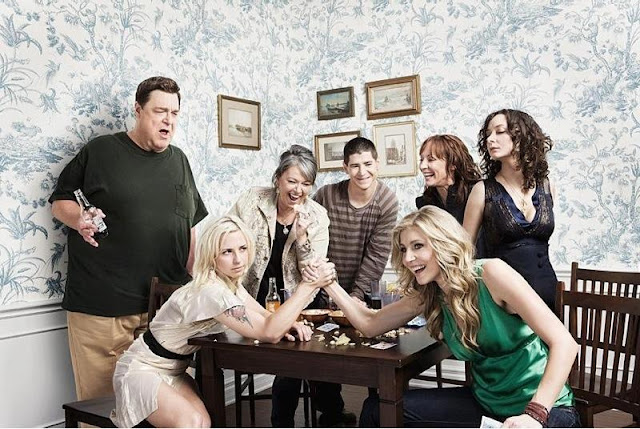 |
|||
| The cast of Roseanne, all grown up |
I grew up watching Roseanne. The show first aired in 1988—when I was ten years old—and it ended after 9 seasons, around the time I graduated high school. The fact that the show now appears in reruns on various television stations, during all hours of the day and night, often makes me feel like the Conners have never not been a part of my life. I saw myself (and my family) in that show, and I identified with the characters and their struggles, particularly surrounding financial issues and social status.
Unfortunately, families like the Conners just don’t exist on TV now, which is extremely problematic considering families today—and women in particular—continue to feel the never-ending effects of Wall Street tanking our economy. We simply no longer see the realities of women’s lives accurately reflected back at us in the media. In fact, I’d go as far as to say that Roseanne, a television show starring a fat, working-class, unapologetically outspoken matriarch; a television show that effectively dealt with racism, classism, feminism, gay marriage (depicting the very first gay marriage in the history of television); a television show openly addressing sexism and misogyny, and yes—a woman’s right to choose; and finally, a television show that first aired nearly 25 years ago, is a far more progressive television show than anything currently gracing the network airwaves in 2012.
You can read the whole thing here. So … who’s up for a Roseanne theme week?
 |
| Promotional poster for the new reality TV series Push Girls |
A new reality TV show called Push Girls, starring four disabled women in wheelchairs, premiered on the Sundance Channel last night. And it’s gotten glowing reviews.
Angela is a stunning model, Auti is a dancer who is trying for a baby, Tiphany is designing a clothes line and Mia works as a graphic designer.
And all four women are paralyzed from the neck or waist down and are about to shatter widespread notions of what it’s like to spend life in a wheelchair.
“Push Girls”, launching on the Sundance Channel on Monday, chronicles the lives of the ambitious and dynamic quartet in a way that producers say has never before been seen on U.S. television.
“Plenty of people have no idea what it’s like to spend the day in the life of someone with a disability, let alone a spinal cord injury,” said Tiphany Adams, 29, who was paralyzed in a horrific 2000 car accident.
“How do we get in and out of a car? How do we go to the bathroom. How do we go grocery shopping? How do we get in the shower? How do we get dressed? I thought it was a brilliant idea for the world to see that,” she said.
Told without self-pity, “Push Girls” shows the women going about their lives in Los Angeles just like other good-looking females in their 20s, 30s and 40s – flirting, going to nightclubs, in bed with boyfriends, chatting about love lives and searching their souls about the future.
But television is a visual medium, and one point the show makes with breathtaking rapidity is that tragedy can interrupt even the most seemingly charmed life. The other, more important point is that it can be just that — an interruption rather than an off-the-rails ending.
“If I can’t stand up, I’m going to stand out,” says one of the women toward the end of the pilot, and that would appear to be its theme.
Where others might have chosen to follow the overtly emotional, “The Other Side of the Mountain”-type story line of agonizing transition from able-bodied to physically challenged, this show does not. Instead, it chooses women who have been in their chairs for at least 10 years — which shows in the grace and ease with which they operate their chairs and perform tasks that, to the able-bodied, would seem impossible without full mobility.
Let’s say this first: Popular television is bad at lots of things, and one of them is representations of people with disabilities. Even where they’re present – Artie on Glee, or Walter, Jr. on Breaking Bad – they tend to be in isolation. When there’s more than one person in a wheelchair, for instance, like when Jason Street was in rehab on Friday Night Lights, the story is usually about the disability itself.
I sat down to think about the last time I saw television pass a sort of invented variation (not parallel, but similar in intent) on the Bechdel test: two people with disabilities talking in depth about things other than their disabilities. I’m sure it’s happened, but I strained to think of examples.
It’s still a reality show, like many others. It’s still a reality show about people who are way too hot to be representative of the population, and about people who gossip about each other and share more personal details than most of us would. To a degree, it truly does just happen to be a show about people in wheelchairs, and that’s probably the best thing it could be.
The premiere episode tends to lapse into a “You go, girl” mode typical of shallow treatments of disability, with fist-pumping and treacly background music. It’s a tone that subtly demeans, suggesting that simple things like having head shots taken (Ms. Rockwood is trying to restart a modeling career) must be applauded because, golly, for someone in a wheelchair to do anything other than sit there is a triumph.
A little of that may be necessary to hook an audience that has come to expect this treatment whenever a person with a disability turns up on television, but the faster this show sheds that tone and its preoccupation with sex, the more useful it will be. There are numerous other things we’d like to know about these interesting women besides the particulars of their love lives: their finances, their experiences on the job, their journey to get to the confidence level they seem to have achieved, their hopes for new technologies and medical breakthroughs.
Another challenge for “Push Girls” is dispelling the impression that these women are representative. Certain viewers might well look at them and conclude, “Gorgeous, smart, independent; I guess the disabled-Americans problem has been solved, so I can go back to not thinking about it.”
Over dinner in Beverly Hills recently, the sisterhood was palpable. Funny and vibrant, the women were as quick to tease each other over entrée choices as they were to argue over who looks the most beautiful when she wakes up in the morning. The tears flowed just as easily when the conversation turned to what their friendship means, and not just for the women. Even Chelsie’s father, Jon Hill, and Rockwood’s caregiver, Aunty Judy, became misty-eyed a couple of times.
“It was such a turning point for Chelsie to meet them all at one time,” Jon Hill said. “She’s always been a happy kid, but when she met the girls and we left there, she was singing and dancing in the car. Just pumped up. That’s what I needed to see. Even though she wasn’t depressed, it was just finding that right niche so she wouldn’t be sitting at home in the chair. It’s helped me tremendously being around these ladies.”
A more subtle aspect of the show is seeing how others react to the Push Girls: from rudeness to confusion, there are many levels of discomfort on display among the able-bodied people featured. How the women deal with the awkwardness varies within the group, but it’s one of the more moving subtexts. There’s a mixture of duty and fatigue when Angela talks a photographer through the reality of her leg spasms as he puts on an awkward grin, unsure of how to handle the fact that she could, at any moment, “stroke out.”
The series starts off with the women beginning their very L.A.-flavored journeys toward starting (or restarting) their careers, and there’s something captivating in that struggle even beyond the affecting nature of seeing these women work to transcend their disabilities. Despite the leisurely pace of the filming, which lacks a certain amount of dramatic tension, there’s a fiery spirit to Push Girls that cannot be ignored.